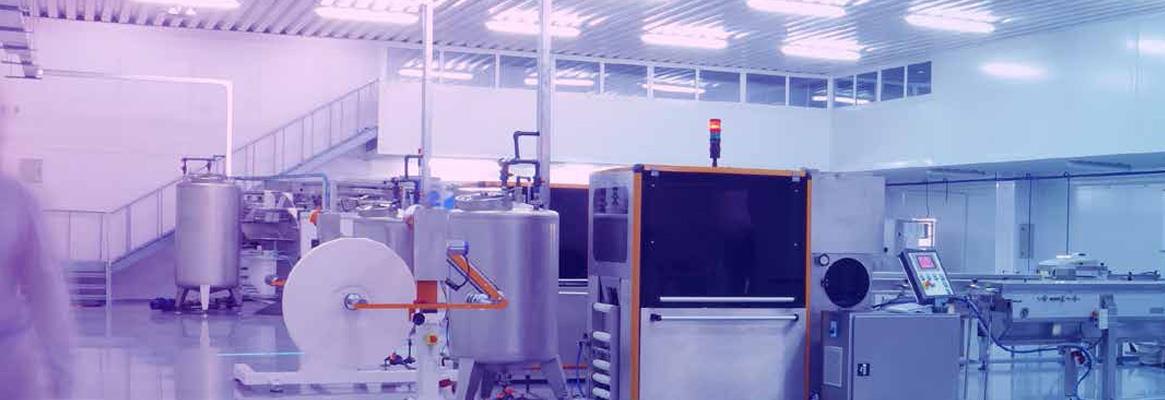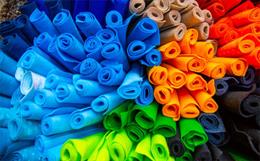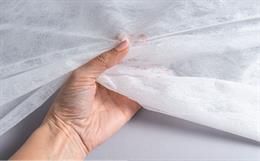The nonwoven fabric, one of the essential raw materials for industrial textiles, is widely used in such industries as medical health, filtration/separation, earthwork/building construction, and automobiles, with incomparable cost-effectiveness and extensive application bestowed upon such fabric featuring special functional structure and high-efficient production processes. In the past years, the increasing demands have boosted the rapid growth in production and consumption of nonwoven fabric across the world. In spite of intricate circumstances at home and abroad, the nonwovens industry in China witnessed growth throughout the year 2016, accompanied by positive momentum in economic benefits, writes Eric(Chuanxiong) Zhang, Secretary-General, China Nonwovens & Industrial Textiles Association.
I.Current Development
1.Production
Judging from statistical data released by China Nonwovens & Industrial Textiles Association (CNITA),the output of nonwoven fabric all over China totalled 5.263 million tons throughout 2016, up by 8.5 per cent compared with the same period in the previous year,which indicates rapid growth. However, the rate of increase was slightly lower than that in 2015. Region-wise, large-scale enterprises based in Shandong Province-the biggest contributor to the aggregate fabric output in China-together produced 947,000 tons in 2016, showing a drastic increase in nonwoven fabric output all over the province, due to increased production capacity owing to surging investments in earthwork and waterproof base fabric of roll goods. Another reason is that several traditional textile manufacturers in Shandong have shifted their businesses to the nonwovens industry, which has given birth to massive investments, state-of-the-art equipment, and high production capacity on the single production line. In Guangdong and Jiangxi provinces, the outputs have risen at around 10 per cent, while provinces like Zhejiang, Fujianand Anhui have registered the growing output at approximately 15 per cent. In the case of the eastern coastal area-the predominant production area of nonwoven fabric in China, the nonwoven fabric production here accounted for 70.2 per cent of the total production across the country. The rate of increase in output also remained at high level as before. Due to the leading industry of disposable medical textiles in central China, western China and Hubei Province,the nonwoven fabric generated in these regions has reached 408,000 tons; provinces like Henan and Sichuan still hold the rapid output growth, though the output in such provinces only takes up tiny percentages of the aggregate throughout the whole country.
 2. Investment
2. Investment
The diverse demands and rapid growth of nonwoven fabric have opened a door for periodically proactive investments in this industry. In 2016, the actual fixed investments in the nonwovens industry amounted to RMB 30.622 billion across China, rising by 13.87 per cent year-on-year, while the increase rate in 2014 was 44.2 per cent as the peak value in recent years. Usually, it takes about one year to put nonwoven fabric production lines into service after investments, during which enterprises absorb newly increasing production capacity. Therefore, it's safe to say the investment growth rate in 2016 has tended to rebound after the drop in 2015, and it is anticipated that the investment in the nonwovens industry will continue to increase at a powerful momentum in 2017.
With reference to CNITA data on several equipment manufacturers, 152 new needling production lines were sold throughout the year 2016 for China's industrial textile industry, together with 33 new stitch-bonding production lines and 19 new hot-air/thermal calendaring production lines, which denotes that this industry still acts as amagnet to investments.
3.Economic Benefit
In past years, the nonwovens industry has firmly clenched strong profitability. As shown in statistics released by National Bureau of Statistics of China (NBSC),large-scale nonwoven fabric enterprises have totally earned RMB 155.84 billion from main business and RMB 9.93 billion as profits, respectively up by 7.67 percent and 8.23 per cent, with the profit rate at 6.38 per cent. The loss amount of unprofitable industrial enterprises has decreased by 43.32 per cent, which signifies that the profitability of this industry is further enhanced by more technical value added from progressive industrial science and technology, and is even elevated by the uninterrupted industrial development due to the benignant circle arising out of production capacity increase, inventory reduction, and receivables decrease for business activities.
For China's nonwovens industry, its main business revenues have witnessed considerable changes in the growth rate. Throughout the year 2016, the growth rate was 12 per cent lower than in 2012, while the overall production capacity has risen significantly in the same period. The growth rate drop in main business revenues largely stems from the encumbrance and even moderate diminishment upon sales prices of nonwoven fabric, owing to the price reduction of raw materials like polypropylene chips and polyester staple fibre driven by tumbling oil prices.
4. International Business

By the end of the year 2016, China exported 821,000 tons of nonwoven fabric valued at $2.52 billion,respectively up by 12.25 per cent and 1.49 per cent. Despite the overall recession in industrial textile exportation, China's nonwovens industry islargely expedited by quantity, and in turn, still takes up favourable percentages of global market shares. From 2012 to 2016, the exported nonwoven fabric has annually increased by 14.08 per cent based on weight, higher than the annual average increase rate of export value. From the perspective of export prices, the unit price has risen at a low speed from 2012 to 2013, buthas declined since 2014. In particular, it has dropped by nearly 10 per cent in 2016, with average export prices decreasing by 2.2 per cent in the last 5 years.
The staple fibre-the dominant type of nonwoven fabric exported from China-enjoys the weight at 51.33 per cent of the total weight. For spun-melt nonwoven fabric delivered from China, its weight shares 48.67 per cent of the aggregate throughout the year 2016, with export value accounting for 43.7 per cent, slightly higher than in2015. From the angle of processes, the nonwoven fabric after treatments like dipping has generated export value at 44.31 per cent of the aggregate, and its unit price is 41.82 per cent higher than that of nonwoven fabric without any treatment, from which it can be understood that finishing plays a significant role in pushing up the added value of nonwoven fabric.
On the basis of markets,Asia, the largest destination of nonwoven fabric exported from China, has generated export value that increases by 2.49 per cent year-on-year, with the percentage beyond 60 per cent of the total. Among other indispensable markets,European Union has imported China-made nonwoven fabric at 2.61 per cent higher than in the same period of the previous year, while the quantity of such fabric exported to North America has declined by 3.9 per cent year-on-year, due to decline in export to the US.
In the case of sales from China to Latin America and Oceania, the export volumes have respectively risen by 5.45 per cent and 18.82 per cent respectively, compared with the same period in the previous year. In 2016, however, the global economic depression has imposed negative influences upon the development of exports to Africa, and as a result, the export volume to this continent has declined by 18.96 per cent year-on-year. Nevertheless, Africa is still brimmed over with development potentials on the whole, and is an optimum flowerbed for China's cost-effective nonwoven fabric in the near future.
II.Industrial Development Tendency
Undoubtedly, China's nonwovens industry has witnessed a rocketing growth during the short period of its development in China. In 2001, the production capacity was merely 569,000 tons, only 10.8 per cent of that in 2016. Within 15 years, however, the annual increase rate of production capacity has reached 16 per cent on average: the export volumes of China's nonwoven fabric have ascended to 732,000 tons in 2015 from 34,000 tons in 2000, lifting export value from $94 million to $2.49 billion, respectively up by 22.58 per cent and 24.4 per cent on average. As for the international business, China's market share has gone up to 17.6 per cent from 2.1 per cent. As a result, China has today evolved as the largest country in terms of production, consumption and sale of nonwoven fabrics globally.

The nonwovens industry in China is enjoying the rapid development. One reason for this is China's tremendous demands for medical health, infrastructure construction and environmental protection, which have attracted investments of worldwide leading nonwoven manufacturers to establish their company in China. Another reason is China's enormous progresses in special raw materials, equipment and production processes for nonwoven fabric, together with generation of specialised talents from various educational institutions, who lent their hand to create complete production chains in China that have remarkably reduced producing costs. For instance, few overseas manufacturers other than Reifenhauser GmbH, a German company, have no longer obtained any equipment orders from China for production of high-end spunbonded fabric. Taken as an example, China's technical breakthrough in polyester reinforcement base fabric has boosted the vigorous increase of production lines for such fabric, and in turn, strong substitution effects are catalysed and imposed upon traditional reinforcement base fabric.Therefore, it's barely facile to replicate such well-developed industrial chains in regions full of producing costs, like Southeast Asia.
1.Domestic Market
1.1Medical Health Industry in Steady Growth
In coming years, markets will retain its role-the prime driver to the growth of China's nonwovens industry. From world perspective, the leading application of nonwoven fabric lies in medical health whose development is intimately correlated with population and demographic structure. In China, the country with the largest population in the world, the market of hygiene textiles is expanding due to rising ageing population and birth rates that have slightly rebound since implementation of the universal two-child policy. As a response to urbanisation and rising incomes, changes in personal consumption habits will be stimulated,and in turn, the market penetration rates of baby diapers, sanitary napkins,and adult diapers will go upward steadily, and eventually, tend to be the same as in developed countries. In case of medical nonwoven fabric, the domestic market is still under incubation with possible large market shares and rapid growth due to the well-developed auxiliary medical insurance and applicable procurement policies in the future.
1.2 Engineering Application in Rocketing Growth
The special structure endows nonwoven fabric with extremely extensive application in the engineering industry. As the efficacious technology on environmental protection testified through verification on both domestic and overseas markets, bag house dusting is further deeply applied in such industries as thermal power generation,steel making/metallurgy, cement, and waste incineration. With more efforts of China's governments on environmental protection, the nonwovens industry will fall into the large growth scope from aspects of air and water filtration. Likewise,industries like earthwork and building construction bring favourable opportunity that strengthens China's infrastructure. In addition, nonwoven fabric is broadly applicable in car interiors, carpets, thermal and sound insulating materials, and filtration materials.
As for industries like packages, cables, and home furnishing, it's inevitable to further research and develop numerous applications that nonwoven fabric has on the basis of advantages in cost and innovation in techniques.
1.3 Emerging Industries with Enormous Potentials

The micro-fibre based fabric industry is also growing favourably. Despite the fact that markets and environmental policies have pushed down the overall synthetic leather industry,the superior performance is embedded in synthetic leather and its base fabric that highlights the industrial development and massively replaces traditional products. Huafon Microfibre (Shanghai) Co Ltd, the leading Chinese manufacturer of micro-fibre based fabric, has ordered 16 needling nonwoven fabric production lines throughout 2016, including 10 Dilo production lines sourced from outside China. Additionally, nonwoven fabric is endowed with enormous potentials for the wall cloth industry. Compared with common wall cloth, the ones made of nonwoven fabrics are more advantageous in cost and performance, owing to the accessible deep development in aspects of sound insulation, mould prevention and touch on the basis of stereo structure.
2. International Market
Since the industry is well-developed, the international market has played a more significant role in China's industry of nonwoven fabric, as the domestic market penetration rate increases. In 2016, totally 732,000 tons of nonwoven fabric is sold from China,accounting to 14 per cent of the aggregate output, and even sharing higher percentages of the needling nonwoven fabric exports. Markets in developed countries have apparently spotlighted cost advantages and strong competitiveness inlaid in China-made nonwoven fabrics. Taking the US as an example, Chinese nonwoven fabric almost didn't take up any market share in the year 2000, while Japanese products shared 27 per cent. In 2016, nonetheless,Chinese products' share ascended to 23 per cent, while the market share of Japanese goods shrunk to 8 per cent. More obviously, the advantages of Chinese nonwoven fabric have swelled in developing countries. In 2016, the nonwoven fabric exported to India, Indonesia, Vietnam and Philippines amounted to $480 million beyond the aggregate from export to the US, Japan and European Union,rising by 4.96 per cent, compared with the same period in the previous year. This unveils the significant role and growth opportunity of developing countries in export destination of China-made nonwoven fabric.
As a response to the advancing 'One Belt One Road' Initiative, more investments from China in terms of infrastructure in countries along the 'Belt' and 'Road' will be seen. Along with that, the transferred production capacity of industries like garments,bags and shoe-making, developing countries will show their increasing demands for nonwoven fabric, which will, in turn, create favourable opportunities in trade and direct investments for China.
To sum up, China's nonwovens industry has been well-developed for over a decade. The enormous market of domestic demands still acts as the vast paradise for the industrial development in China. With benefits from both growing economy and increasing infrastructure projects in developing countries, such markets are bound to be growth points of China's nonwoven industry. Moreover, the technical innovation in aspects of equipment, raw material and processes for China's nonwoven industry will give an impetus to new products and applications, with a view to effective substitution for traditional products and unceasing market expansion for nonwoven fabric. Therefore, it's safe to say that China's nonwovens industry will embrace a marvellous future, and will never balk in achieving growth at a high speed. (JI Jianbing)







